Impact of High Employee Turnover on Motivation and Management
VerifiedAdded on 2023/06/18
|25
|5401
|208
Report
AI Summary
This research report investigates the impact of high employee turnover on employee motivation and management within Boots Retail. It aims to understand talent management and motivation schemes, analyze the impact of these schemes on employee retention, identify the challenges faced by Boots Retail due to turnover, and determine suitable ways to mitigate the issue and increase talent retention. The study employs a deductive approach, utilizing survey strategies and quantitative research methods to gather and analyze data. Key findings are presented and discussed, leading to conclusions and recommendations for Boots Retail to address employee turnover and improve motivation, including strategies such as rewards, recognition, and training and development programs.

Research project
(To identify the impact of high employee turnover on
employee motivation and management. A study on
Boots Retail)
(To identify the impact of high employee turnover on
employee motivation and management. A study on
Boots Retail)
Paraphrase This Document
Need a fresh take? Get an instant paraphrase of this document with our AI Paraphraser
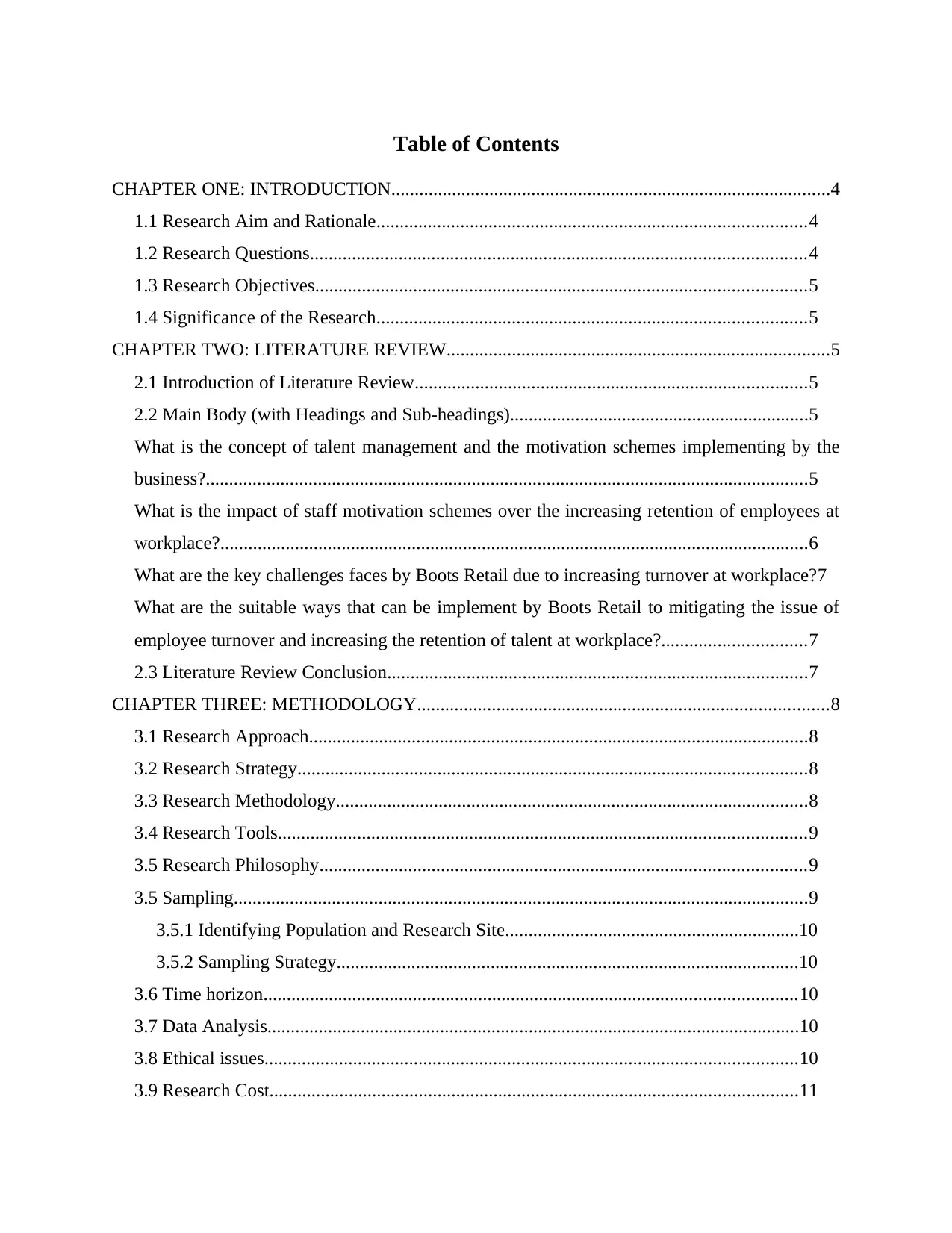
Table of Contents
CHAPTER ONE: INTRODUCTION..............................................................................................4
1.1 Research Aim and Rationale............................................................................................4
1.2 Research Questions..........................................................................................................4
1.3 Research Objectives.........................................................................................................5
1.4 Significance of the Research............................................................................................5
CHAPTER TWO: LITERATURE REVIEW..................................................................................5
2.1 Introduction of Literature Review....................................................................................5
2.2 Main Body (with Headings and Sub-headings)................................................................5
What is the concept of talent management and the motivation schemes implementing by the
business?.................................................................................................................................5
What is the impact of staff motivation schemes over the increasing retention of employees at
workplace?..............................................................................................................................6
What are the key challenges faces by Boots Retail due to increasing turnover at workplace?7
What are the suitable ways that can be implement by Boots Retail to mitigating the issue of
employee turnover and increasing the retention of talent at workplace?...............................7
2.3 Literature Review Conclusion..........................................................................................7
CHAPTER THREE: METHODOLOGY........................................................................................8
3.1 Research Approach...........................................................................................................8
3.2 Research Strategy.............................................................................................................8
3.3 Research Methodology.....................................................................................................8
3.4 Research Tools.................................................................................................................9
3.5 Research Philosophy........................................................................................................9
3.5 Sampling...........................................................................................................................9
3.5.1 Identifying Population and Research Site...............................................................10
3.5.2 Sampling Strategy...................................................................................................10
3.6 Time horizon..................................................................................................................10
3.7 Data Analysis..................................................................................................................10
3.8 Ethical issues..................................................................................................................10
3.9 Research Cost.................................................................................................................11
CHAPTER ONE: INTRODUCTION..............................................................................................4
1.1 Research Aim and Rationale............................................................................................4
1.2 Research Questions..........................................................................................................4
1.3 Research Objectives.........................................................................................................5
1.4 Significance of the Research............................................................................................5
CHAPTER TWO: LITERATURE REVIEW..................................................................................5
2.1 Introduction of Literature Review....................................................................................5
2.2 Main Body (with Headings and Sub-headings)................................................................5
What is the concept of talent management and the motivation schemes implementing by the
business?.................................................................................................................................5
What is the impact of staff motivation schemes over the increasing retention of employees at
workplace?..............................................................................................................................6
What are the key challenges faces by Boots Retail due to increasing turnover at workplace?7
What are the suitable ways that can be implement by Boots Retail to mitigating the issue of
employee turnover and increasing the retention of talent at workplace?...............................7
2.3 Literature Review Conclusion..........................................................................................7
CHAPTER THREE: METHODOLOGY........................................................................................8
3.1 Research Approach...........................................................................................................8
3.2 Research Strategy.............................................................................................................8
3.3 Research Methodology.....................................................................................................8
3.4 Research Tools.................................................................................................................9
3.5 Research Philosophy........................................................................................................9
3.5 Sampling...........................................................................................................................9
3.5.1 Identifying Population and Research Site...............................................................10
3.5.2 Sampling Strategy...................................................................................................10
3.6 Time horizon..................................................................................................................10
3.7 Data Analysis..................................................................................................................10
3.8 Ethical issues..................................................................................................................10
3.9 Research Cost.................................................................................................................11

CHAPTER FOUR: DATA FINDINGS & PRESENTATION......................................................12
Data presentation..................................................................................................................12
CHAPTER FIVE: DATA INTERPRETATION & DISCUSSION..............................................18
CHAPTER SIX: CONCLUSION, RECOMMENDATIONS & EXECUTION FOR FURTHER
RESEARCH...................................................................................................................................20
Conclusion............................................................................................................................20
Recommendations................................................................................................................20
REFERENCES..............................................................................................................................21
APPENDIX....................................................................................................................................22
Questionnaire........................................................................................................................22
Frequency Distribution Table...............................................................................................23
Data presentation..................................................................................................................12
CHAPTER FIVE: DATA INTERPRETATION & DISCUSSION..............................................18
CHAPTER SIX: CONCLUSION, RECOMMENDATIONS & EXECUTION FOR FURTHER
RESEARCH...................................................................................................................................20
Conclusion............................................................................................................................20
Recommendations................................................................................................................20
REFERENCES..............................................................................................................................21
APPENDIX....................................................................................................................................22
Questionnaire........................................................................................................................22
Frequency Distribution Table...............................................................................................23
⊘ This is a preview!⊘
Do you want full access?
Subscribe today to unlock all pages.

Trusted by 1+ million students worldwide

CHAPTER ONE: INTRODUCTION
1.1 Research Aim and Rationale
Research Aim
To identify the impact of high employee turnover on employee motivation and
management. A study on Boots Retail.
Research rationale
The main rationale beyond the present research is to generate an understanding in relation
to talent management and motivation schemes used within an organisation. This is analysed that
there is a presence of different aspects that are essential to be undertaken so that to develop
business in such a way that this would develop the business and helps in attaining business
objectives as well. In this manner talent management is regarded as one of the major practices
that is being utilized by various organisations in respect to mitigate various challenges faced in
their business (Ritala, Vanhala and Järveläinen, 2020). This research report is related with
developing such insight within reader so that differential aspects can be understood by reader in
which they can provide their assistance in dealing with talent management dimension in their
working organisation. Besides this the present research is related with multi perspectives like
professional and personal. In context to personal perceptive this research helps a researcher in
respect to enhance various skills by which they can develop future researches in appropriate
manner. Whereas, in terms of professional perspective the present research would provide
assistance for research in their further researches in appropriate manner.
1.2 Research Questions
What is the concept of talent management and the motivation schemes implementing by
the business?
What is the impact of staff motivation schemes over the increasing retention of
employees at workplace?
What are the key challenges faces by Boots Retail due to increasing turnover at
workplace?
What are the suitable ways that can be implement by Boots Retail to mitigating the issue
of employee turnover and increasing the retention of talent at workplace?
1.1 Research Aim and Rationale
Research Aim
To identify the impact of high employee turnover on employee motivation and
management. A study on Boots Retail.
Research rationale
The main rationale beyond the present research is to generate an understanding in relation
to talent management and motivation schemes used within an organisation. This is analysed that
there is a presence of different aspects that are essential to be undertaken so that to develop
business in such a way that this would develop the business and helps in attaining business
objectives as well. In this manner talent management is regarded as one of the major practices
that is being utilized by various organisations in respect to mitigate various challenges faced in
their business (Ritala, Vanhala and Järveläinen, 2020). This research report is related with
developing such insight within reader so that differential aspects can be understood by reader in
which they can provide their assistance in dealing with talent management dimension in their
working organisation. Besides this the present research is related with multi perspectives like
professional and personal. In context to personal perceptive this research helps a researcher in
respect to enhance various skills by which they can develop future researches in appropriate
manner. Whereas, in terms of professional perspective the present research would provide
assistance for research in their further researches in appropriate manner.
1.2 Research Questions
What is the concept of talent management and the motivation schemes implementing by
the business?
What is the impact of staff motivation schemes over the increasing retention of
employees at workplace?
What are the key challenges faces by Boots Retail due to increasing turnover at
workplace?
What are the suitable ways that can be implement by Boots Retail to mitigating the issue
of employee turnover and increasing the retention of talent at workplace?
Paraphrase This Document
Need a fresh take? Get an instant paraphrase of this document with our AI Paraphraser
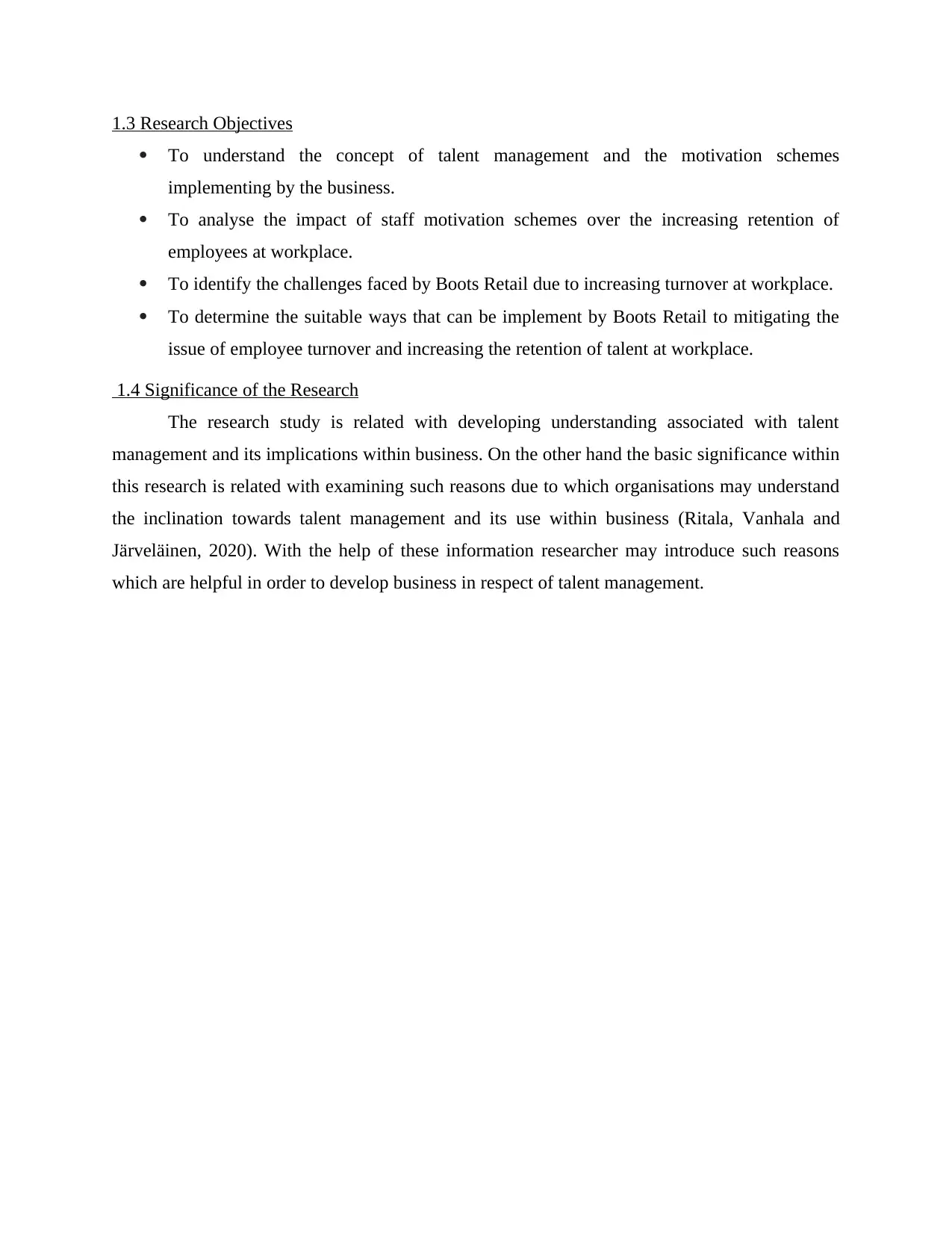
1.3 Research Objectives
To understand the concept of talent management and the motivation schemes
implementing by the business.
To analyse the impact of staff motivation schemes over the increasing retention of
employees at workplace.
To identify the challenges faced by Boots Retail due to increasing turnover at workplace.
To determine the suitable ways that can be implement by Boots Retail to mitigating the
issue of employee turnover and increasing the retention of talent at workplace.
1.4 Significance of the Research
The research study is related with developing understanding associated with talent
management and its implications within business. On the other hand the basic significance within
this research is related with examining such reasons due to which organisations may understand
the inclination towards talent management and its use within business (Ritala, Vanhala and
Järveläinen, 2020). With the help of these information researcher may introduce such reasons
which are helpful in order to develop business in respect of talent management.
To understand the concept of talent management and the motivation schemes
implementing by the business.
To analyse the impact of staff motivation schemes over the increasing retention of
employees at workplace.
To identify the challenges faced by Boots Retail due to increasing turnover at workplace.
To determine the suitable ways that can be implement by Boots Retail to mitigating the
issue of employee turnover and increasing the retention of talent at workplace.
1.4 Significance of the Research
The research study is related with developing understanding associated with talent
management and its implications within business. On the other hand the basic significance within
this research is related with examining such reasons due to which organisations may understand
the inclination towards talent management and its use within business (Ritala, Vanhala and
Järveläinen, 2020). With the help of these information researcher may introduce such reasons
which are helpful in order to develop business in respect of talent management.
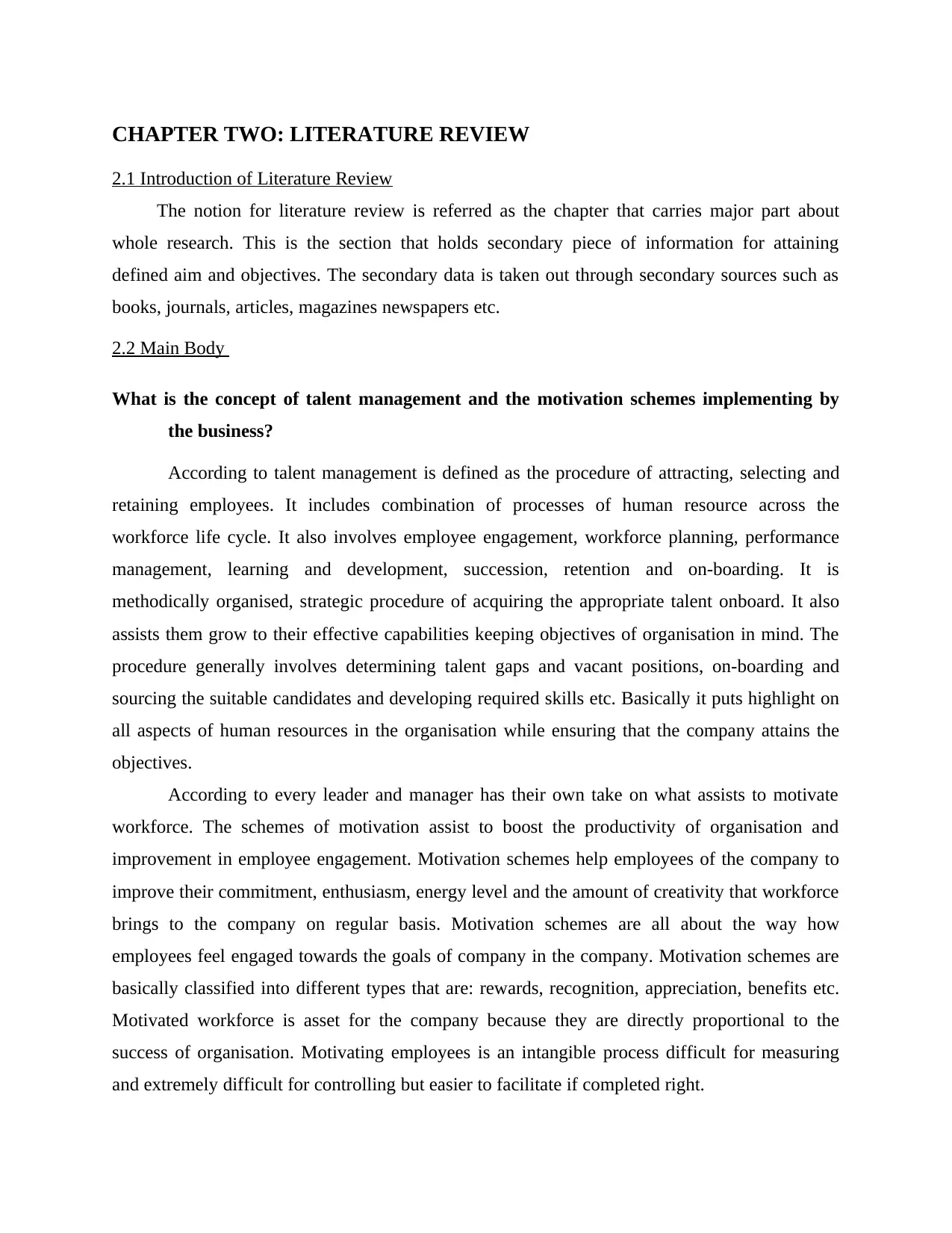
CHAPTER TWO: LITERATURE REVIEW
2.1 Introduction of Literature Review
The notion for literature review is referred as the chapter that carries major part about
whole research. This is the section that holds secondary piece of information for attaining
defined aim and objectives. The secondary data is taken out through secondary sources such as
books, journals, articles, magazines newspapers etc.
2.2 Main Body
What is the concept of talent management and the motivation schemes implementing by
the business?
According to talent management is defined as the procedure of attracting, selecting and
retaining employees. It includes combination of processes of human resource across the
workforce life cycle. It also involves employee engagement, workforce planning, performance
management, learning and development, succession, retention and on-boarding. It is
methodically organised, strategic procedure of acquiring the appropriate talent onboard. It also
assists them grow to their effective capabilities keeping objectives of organisation in mind. The
procedure generally involves determining talent gaps and vacant positions, on-boarding and
sourcing the suitable candidates and developing required skills etc. Basically it puts highlight on
all aspects of human resources in the organisation while ensuring that the company attains the
objectives.
According to every leader and manager has their own take on what assists to motivate
workforce. The schemes of motivation assist to boost the productivity of organisation and
improvement in employee engagement. Motivation schemes help employees of the company to
improve their commitment, enthusiasm, energy level and the amount of creativity that workforce
brings to the company on regular basis. Motivation schemes are all about the way how
employees feel engaged towards the goals of company in the company. Motivation schemes are
basically classified into different types that are: rewards, recognition, appreciation, benefits etc.
Motivated workforce is asset for the company because they are directly proportional to the
success of organisation. Motivating employees is an intangible process difficult for measuring
and extremely difficult for controlling but easier to facilitate if completed right.
2.1 Introduction of Literature Review
The notion for literature review is referred as the chapter that carries major part about
whole research. This is the section that holds secondary piece of information for attaining
defined aim and objectives. The secondary data is taken out through secondary sources such as
books, journals, articles, magazines newspapers etc.
2.2 Main Body
What is the concept of talent management and the motivation schemes implementing by
the business?
According to talent management is defined as the procedure of attracting, selecting and
retaining employees. It includes combination of processes of human resource across the
workforce life cycle. It also involves employee engagement, workforce planning, performance
management, learning and development, succession, retention and on-boarding. It is
methodically organised, strategic procedure of acquiring the appropriate talent onboard. It also
assists them grow to their effective capabilities keeping objectives of organisation in mind. The
procedure generally involves determining talent gaps and vacant positions, on-boarding and
sourcing the suitable candidates and developing required skills etc. Basically it puts highlight on
all aspects of human resources in the organisation while ensuring that the company attains the
objectives.
According to every leader and manager has their own take on what assists to motivate
workforce. The schemes of motivation assist to boost the productivity of organisation and
improvement in employee engagement. Motivation schemes help employees of the company to
improve their commitment, enthusiasm, energy level and the amount of creativity that workforce
brings to the company on regular basis. Motivation schemes are all about the way how
employees feel engaged towards the goals of company in the company. Motivation schemes are
basically classified into different types that are: rewards, recognition, appreciation, benefits etc.
Motivated workforce is asset for the company because they are directly proportional to the
success of organisation. Motivating employees is an intangible process difficult for measuring
and extremely difficult for controlling but easier to facilitate if completed right.
⊘ This is a preview!⊘
Do you want full access?
Subscribe today to unlock all pages.

Trusted by 1+ million students worldwide

What is the impact of staff motivation schemes over the increasing retention of employees
at workplace?
According to retention of employees includes different steps taken for retaining
employees who wishes to move on. Staff motivation schemes play significant role in retention of
employees and satisfaction of employees. It has been identified that motivation schemes have
positive impact in increasing retention of employees in the workplace because with these
employees are encouraged to work hard and achieve their objectives. Employees are provided
motivation schemes such as monetary and non-monetary benefits. There are many employees in
the organisation who get motivated and encouraged with the monetary schemes of motivation
because this helps in improving their well-being as well as fulfil their financial needs and
requirements. Employees who are more inclined towards getting financial benefits have more
chances to stay in the same company so it is very clear that monetary staff motivation schemes
have positive effect upon employee retention. The other motivation schemes such as appreciation
and recognition also have positive impact on the retention of employees because it builds up
their confidence in doing their work. Hence, it could be clearly said that staff motivation
schemes is positively related to retention of workforce.
What are the key challenges faces by Boots Retail due to increasing turnover at workplace?
According to a company faces different types of challenges when it is unable to manage
and organise employees. Boots parent company has faced 26% reduction in its standardized
gross profit in the division of global retain pharmacy in a period of three months. The sales of
Boots have reduced about 29% as it is being recorded that footfall in the stores have reduced
because of changing market requirements and due to inefficiency of employees. Some of the
major challenges that are faced by Boots retail due to increasing turnover at workplace are:
Unattained targets and objectives: One of the major challenges related to increased
employee turnover is unattained targets and objectives of the company. When employees leave
the organisation it creates chaos and confusion and objectives remain unattained.
Ineffective customer service: The other major challenges is ineffective customer service
due to employees leaving the organisation. When employees leave the company then it creates
negative impact on existing employees and they become ineffective in providing great customer
service.
at workplace?
According to retention of employees includes different steps taken for retaining
employees who wishes to move on. Staff motivation schemes play significant role in retention of
employees and satisfaction of employees. It has been identified that motivation schemes have
positive impact in increasing retention of employees in the workplace because with these
employees are encouraged to work hard and achieve their objectives. Employees are provided
motivation schemes such as monetary and non-monetary benefits. There are many employees in
the organisation who get motivated and encouraged with the monetary schemes of motivation
because this helps in improving their well-being as well as fulfil their financial needs and
requirements. Employees who are more inclined towards getting financial benefits have more
chances to stay in the same company so it is very clear that monetary staff motivation schemes
have positive effect upon employee retention. The other motivation schemes such as appreciation
and recognition also have positive impact on the retention of employees because it builds up
their confidence in doing their work. Hence, it could be clearly said that staff motivation
schemes is positively related to retention of workforce.
What are the key challenges faces by Boots Retail due to increasing turnover at workplace?
According to a company faces different types of challenges when it is unable to manage
and organise employees. Boots parent company has faced 26% reduction in its standardized
gross profit in the division of global retain pharmacy in a period of three months. The sales of
Boots have reduced about 29% as it is being recorded that footfall in the stores have reduced
because of changing market requirements and due to inefficiency of employees. Some of the
major challenges that are faced by Boots retail due to increasing turnover at workplace are:
Unattained targets and objectives: One of the major challenges related to increased
employee turnover is unattained targets and objectives of the company. When employees leave
the organisation it creates chaos and confusion and objectives remain unattained.
Ineffective customer service: The other major challenges is ineffective customer service
due to employees leaving the organisation. When employees leave the company then it creates
negative impact on existing employees and they become ineffective in providing great customer
service.
Paraphrase This Document
Need a fresh take? Get an instant paraphrase of this document with our AI Paraphraser

What are the suitable ways that can be implement by Boots Retail to mitigating the issue of
employee turnover and increasing the retention of talent at workplace?
According to there are many ways that could be implemented by Boots Retail to mitigate
the problem of staff turnover & enhancing the employee’s talent retention at workplace such as
rewards, recognition, training and development, monetary benefits. Monetary benefits are one of
the ways that play major role in decreasing employee turnover because it fulfills the monetary
requirement of employees. Training and development is another way that could be used for
increasing the retention of talent because it improves their skills and knowledge in the
workplace.
2.3 Literature Review Conclusion
From the above accumulated data it is concluded that motivational techniques are very
important in the organisation because it helps in attracting and retaining large number of talents.
It is also identified that it has positive impact on company as it is directly connected to the
retention of employees.
employee turnover and increasing the retention of talent at workplace?
According to there are many ways that could be implemented by Boots Retail to mitigate
the problem of staff turnover & enhancing the employee’s talent retention at workplace such as
rewards, recognition, training and development, monetary benefits. Monetary benefits are one of
the ways that play major role in decreasing employee turnover because it fulfills the monetary
requirement of employees. Training and development is another way that could be used for
increasing the retention of talent because it improves their skills and knowledge in the
workplace.
2.3 Literature Review Conclusion
From the above accumulated data it is concluded that motivational techniques are very
important in the organisation because it helps in attracting and retaining large number of talents.
It is also identified that it has positive impact on company as it is directly connected to the
retention of employees.
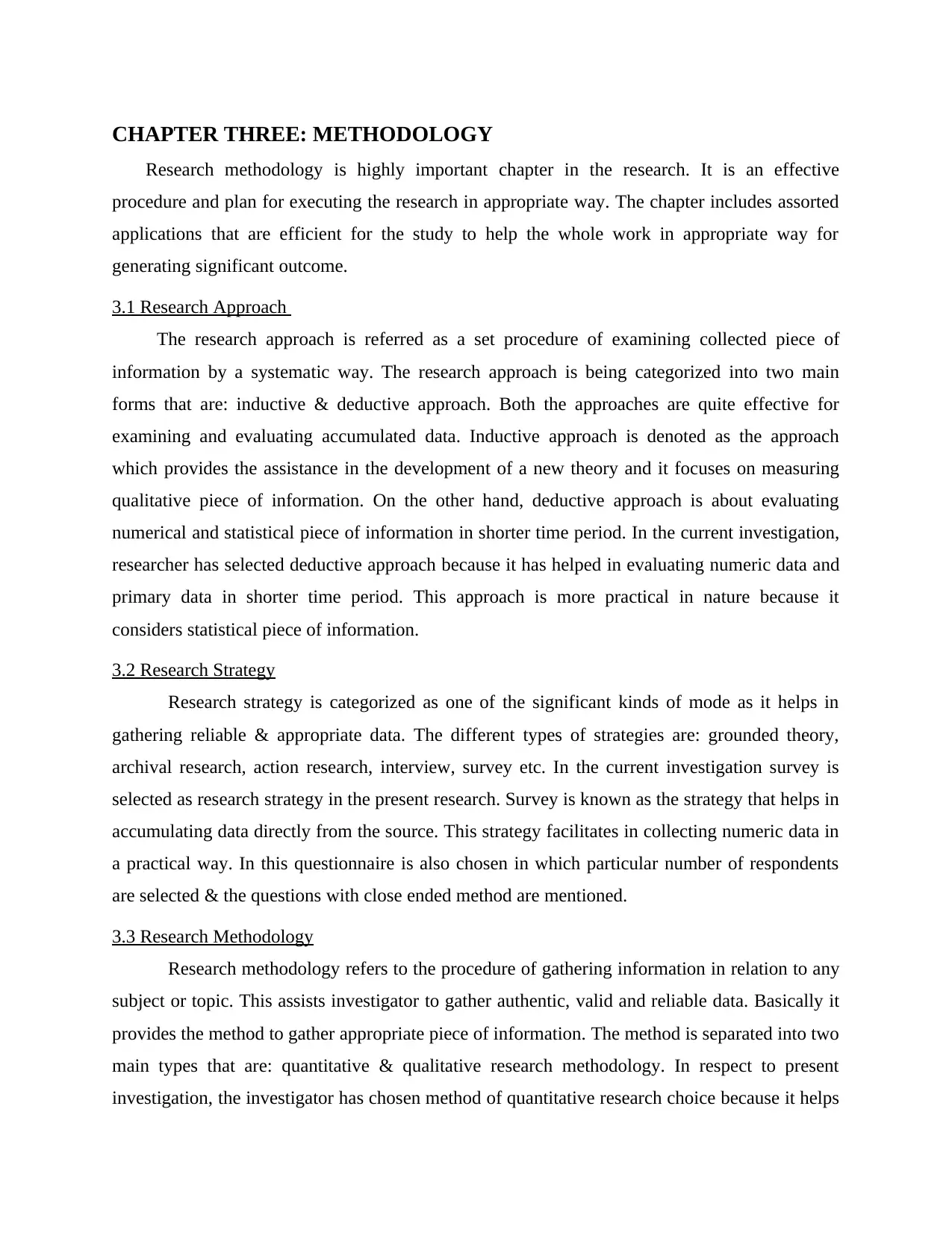
CHAPTER THREE: METHODOLOGY
Research methodology is highly important chapter in the research. It is an effective
procedure and plan for executing the research in appropriate way. The chapter includes assorted
applications that are efficient for the study to help the whole work in appropriate way for
generating significant outcome.
3.1 Research Approach
The research approach is referred as a set procedure of examining collected piece of
information by a systematic way. The research approach is being categorized into two main
forms that are: inductive & deductive approach. Both the approaches are quite effective for
examining and evaluating accumulated data. Inductive approach is denoted as the approach
which provides the assistance in the development of a new theory and it focuses on measuring
qualitative piece of information. On the other hand, deductive approach is about evaluating
numerical and statistical piece of information in shorter time period. In the current investigation,
researcher has selected deductive approach because it has helped in evaluating numeric data and
primary data in shorter time period. This approach is more practical in nature because it
considers statistical piece of information.
3.2 Research Strategy
Research strategy is categorized as one of the significant kinds of mode as it helps in
gathering reliable & appropriate data. The different types of strategies are: grounded theory,
archival research, action research, interview, survey etc. In the current investigation survey is
selected as research strategy in the present research. Survey is known as the strategy that helps in
accumulating data directly from the source. This strategy facilitates in collecting numeric data in
a practical way. In this questionnaire is also chosen in which particular number of respondents
are selected & the questions with close ended method are mentioned.
3.3 Research Methodology
Research methodology refers to the procedure of gathering information in relation to any
subject or topic. This assists investigator to gather authentic, valid and reliable data. Basically it
provides the method to gather appropriate piece of information. The method is separated into two
main types that are: quantitative & qualitative research methodology. In respect to present
investigation, the investigator has chosen method of quantitative research choice because it helps
Research methodology is highly important chapter in the research. It is an effective
procedure and plan for executing the research in appropriate way. The chapter includes assorted
applications that are efficient for the study to help the whole work in appropriate way for
generating significant outcome.
3.1 Research Approach
The research approach is referred as a set procedure of examining collected piece of
information by a systematic way. The research approach is being categorized into two main
forms that are: inductive & deductive approach. Both the approaches are quite effective for
examining and evaluating accumulated data. Inductive approach is denoted as the approach
which provides the assistance in the development of a new theory and it focuses on measuring
qualitative piece of information. On the other hand, deductive approach is about evaluating
numerical and statistical piece of information in shorter time period. In the current investigation,
researcher has selected deductive approach because it has helped in evaluating numeric data and
primary data in shorter time period. This approach is more practical in nature because it
considers statistical piece of information.
3.2 Research Strategy
Research strategy is categorized as one of the significant kinds of mode as it helps in
gathering reliable & appropriate data. The different types of strategies are: grounded theory,
archival research, action research, interview, survey etc. In the current investigation survey is
selected as research strategy in the present research. Survey is known as the strategy that helps in
accumulating data directly from the source. This strategy facilitates in collecting numeric data in
a practical way. In this questionnaire is also chosen in which particular number of respondents
are selected & the questions with close ended method are mentioned.
3.3 Research Methodology
Research methodology refers to the procedure of gathering information in relation to any
subject or topic. This assists investigator to gather authentic, valid and reliable data. Basically it
provides the method to gather appropriate piece of information. The method is separated into two
main types that are: quantitative & qualitative research methodology. In respect to present
investigation, the investigator has chosen method of quantitative research choice because it helps
⊘ This is a preview!⊘
Do you want full access?
Subscribe today to unlock all pages.

Trusted by 1+ million students worldwide

in carrying out statistical and numerical data without consuming long time period. Investigator
has not selected qualitative research choice because it only covers non-numeric information. The
major reason of selecting quantitative research methodology is it supports the technique of
questionnaire for collecting numerical piece of information.
3.4 Research Tools
Data collection is referred as the research methodology that facilitates researcher to carry
out research effectively and efficiently by accumulating appropriate data. It is very important for
investigator to choose valid, accurate and relevant data to take out defined results. There is an
existence of two major forms of data collection that is: primary as well as secondary data
gathering. Researcher has selected primary as well as secondary data collection. Primary data
collection refers to the methodology through which investigator takes out first hand information.
Generally, this is the data that is taken for the very first time directly from the source. For
gathering primary data, questionnaire is formed with close-ended questions in systematic
manner.
Secondary data collection is the type of collection that assists in carrying out published
data in proper and systematic way. In this researcher has focused towards taking out the used
data from different sources such as journals, articles, books, newspapers etc.
3.5 Research Philosophy
The research philosophy is referred as a value in relation to the way within which data
related to the topic must be gathered and utilized. The research philosophy is represented into
three major types which are: epistemology, ontology and axiology. Investigator has relied upon
the philosophy of epistemology as it is also categorized into three main sub parts that are:
interpretivism, positivism & realism. The investigator has selected positivism philosophy of
research as it helps in examining numerical piece of data within shorter span of time duration.
The major benefit of considering positivism type of philosophy is cost and time effective for
achieving defined objectives.
3.5 Sampling
Sampling refers to the process through which specific amount of samples are chosen
from the available large size of population. It is definitely not a smooth procedure of evalutaing
& selecting the available population. It is crucial process for researcher to select appropriate
has not selected qualitative research choice because it only covers non-numeric information. The
major reason of selecting quantitative research methodology is it supports the technique of
questionnaire for collecting numerical piece of information.
3.4 Research Tools
Data collection is referred as the research methodology that facilitates researcher to carry
out research effectively and efficiently by accumulating appropriate data. It is very important for
investigator to choose valid, accurate and relevant data to take out defined results. There is an
existence of two major forms of data collection that is: primary as well as secondary data
gathering. Researcher has selected primary as well as secondary data collection. Primary data
collection refers to the methodology through which investigator takes out first hand information.
Generally, this is the data that is taken for the very first time directly from the source. For
gathering primary data, questionnaire is formed with close-ended questions in systematic
manner.
Secondary data collection is the type of collection that assists in carrying out published
data in proper and systematic way. In this researcher has focused towards taking out the used
data from different sources such as journals, articles, books, newspapers etc.
3.5 Research Philosophy
The research philosophy is referred as a value in relation to the way within which data
related to the topic must be gathered and utilized. The research philosophy is represented into
three major types which are: epistemology, ontology and axiology. Investigator has relied upon
the philosophy of epistemology as it is also categorized into three main sub parts that are:
interpretivism, positivism & realism. The investigator has selected positivism philosophy of
research as it helps in examining numerical piece of data within shorter span of time duration.
The major benefit of considering positivism type of philosophy is cost and time effective for
achieving defined objectives.
3.5 Sampling
Sampling refers to the process through which specific amount of samples are chosen
from the available large size of population. It is definitely not a smooth procedure of evalutaing
& selecting the available population. It is crucial process for researcher to select appropriate
Paraphrase This Document
Need a fresh take? Get an instant paraphrase of this document with our AI Paraphraser
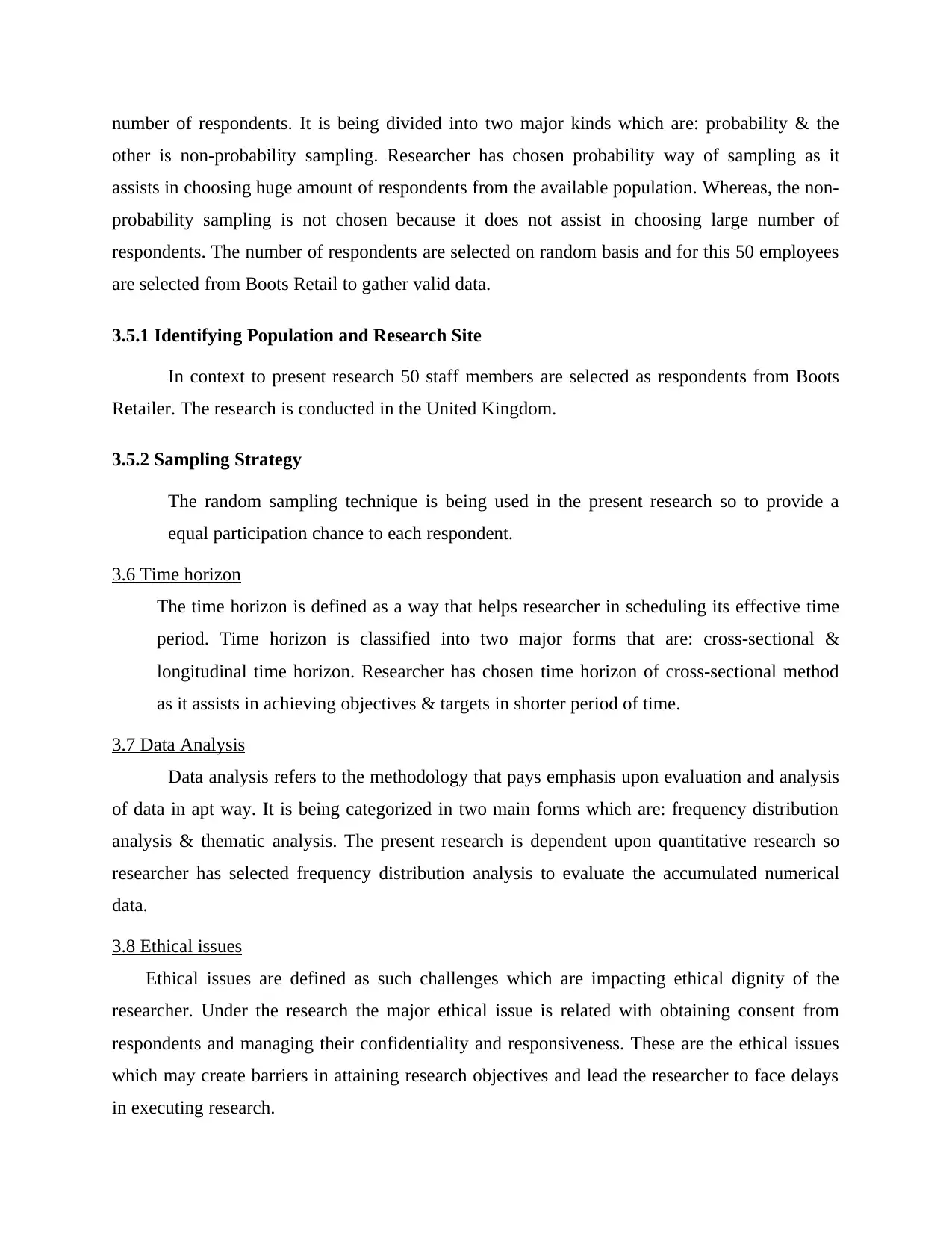
number of respondents. It is being divided into two major kinds which are: probability & the
other is non-probability sampling. Researcher has chosen probability way of sampling as it
assists in choosing huge amount of respondents from the available population. Whereas, the non-
probability sampling is not chosen because it does not assist in choosing large number of
respondents. The number of respondents are selected on random basis and for this 50 employees
are selected from Boots Retail to gather valid data.
3.5.1 Identifying Population and Research Site
In context to present research 50 staff members are selected as respondents from Boots
Retailer. The research is conducted in the United Kingdom.
3.5.2 Sampling Strategy
The random sampling technique is being used in the present research so to provide a
equal participation chance to each respondent.
3.6 Time horizon
The time horizon is defined as a way that helps researcher in scheduling its effective time
period. Time horizon is classified into two major forms that are: cross-sectional &
longitudinal time horizon. Researcher has chosen time horizon of cross-sectional method
as it assists in achieving objectives & targets in shorter period of time.
3.7 Data Analysis
Data analysis refers to the methodology that pays emphasis upon evaluation and analysis
of data in apt way. It is being categorized in two main forms which are: frequency distribution
analysis & thematic analysis. The present research is dependent upon quantitative research so
researcher has selected frequency distribution analysis to evaluate the accumulated numerical
data.
3.8 Ethical issues
Ethical issues are defined as such challenges which are impacting ethical dignity of the
researcher. Under the research the major ethical issue is related with obtaining consent from
respondents and managing their confidentiality and responsiveness. These are the ethical issues
which may create barriers in attaining research objectives and lead the researcher to face delays
in executing research.
other is non-probability sampling. Researcher has chosen probability way of sampling as it
assists in choosing huge amount of respondents from the available population. Whereas, the non-
probability sampling is not chosen because it does not assist in choosing large number of
respondents. The number of respondents are selected on random basis and for this 50 employees
are selected from Boots Retail to gather valid data.
3.5.1 Identifying Population and Research Site
In context to present research 50 staff members are selected as respondents from Boots
Retailer. The research is conducted in the United Kingdom.
3.5.2 Sampling Strategy
The random sampling technique is being used in the present research so to provide a
equal participation chance to each respondent.
3.6 Time horizon
The time horizon is defined as a way that helps researcher in scheduling its effective time
period. Time horizon is classified into two major forms that are: cross-sectional &
longitudinal time horizon. Researcher has chosen time horizon of cross-sectional method
as it assists in achieving objectives & targets in shorter period of time.
3.7 Data Analysis
Data analysis refers to the methodology that pays emphasis upon evaluation and analysis
of data in apt way. It is being categorized in two main forms which are: frequency distribution
analysis & thematic analysis. The present research is dependent upon quantitative research so
researcher has selected frequency distribution analysis to evaluate the accumulated numerical
data.
3.8 Ethical issues
Ethical issues are defined as such challenges which are impacting ethical dignity of the
researcher. Under the research the major ethical issue is related with obtaining consent from
respondents and managing their confidentiality and responsiveness. These are the ethical issues
which may create barriers in attaining research objectives and lead the researcher to face delays
in executing research.
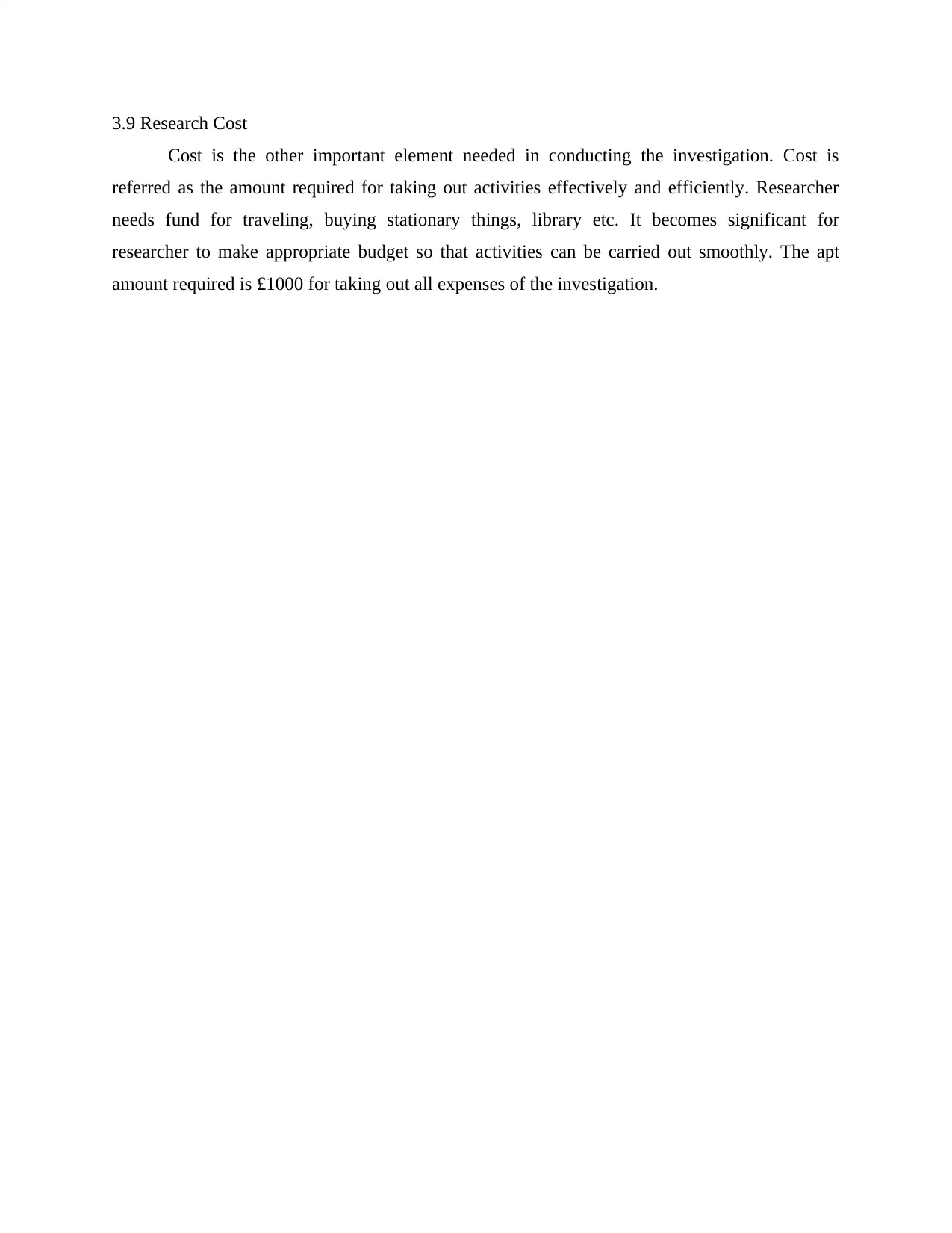
3.9 Research Cost
Cost is the other important element needed in conducting the investigation. Cost is
referred as the amount required for taking out activities effectively and efficiently. Researcher
needs fund for traveling, buying stationary things, library etc. It becomes significant for
researcher to make appropriate budget so that activities can be carried out smoothly. The apt
amount required is £1000 for taking out all expenses of the investigation.
Cost is the other important element needed in conducting the investigation. Cost is
referred as the amount required for taking out activities effectively and efficiently. Researcher
needs fund for traveling, buying stationary things, library etc. It becomes significant for
researcher to make appropriate budget so that activities can be carried out smoothly. The apt
amount required is £1000 for taking out all expenses of the investigation.
⊘ This is a preview!⊘
Do you want full access?
Subscribe today to unlock all pages.

Trusted by 1+ million students worldwide
1 out of 25
Related Documents
Your All-in-One AI-Powered Toolkit for Academic Success.
+13062052269
info@desklib.com
Available 24*7 on WhatsApp / Email
![[object Object]](/_next/static/media/star-bottom.7253800d.svg)
Unlock your academic potential
Copyright © 2020–2025 A2Z Services. All Rights Reserved. Developed and managed by ZUCOL.



